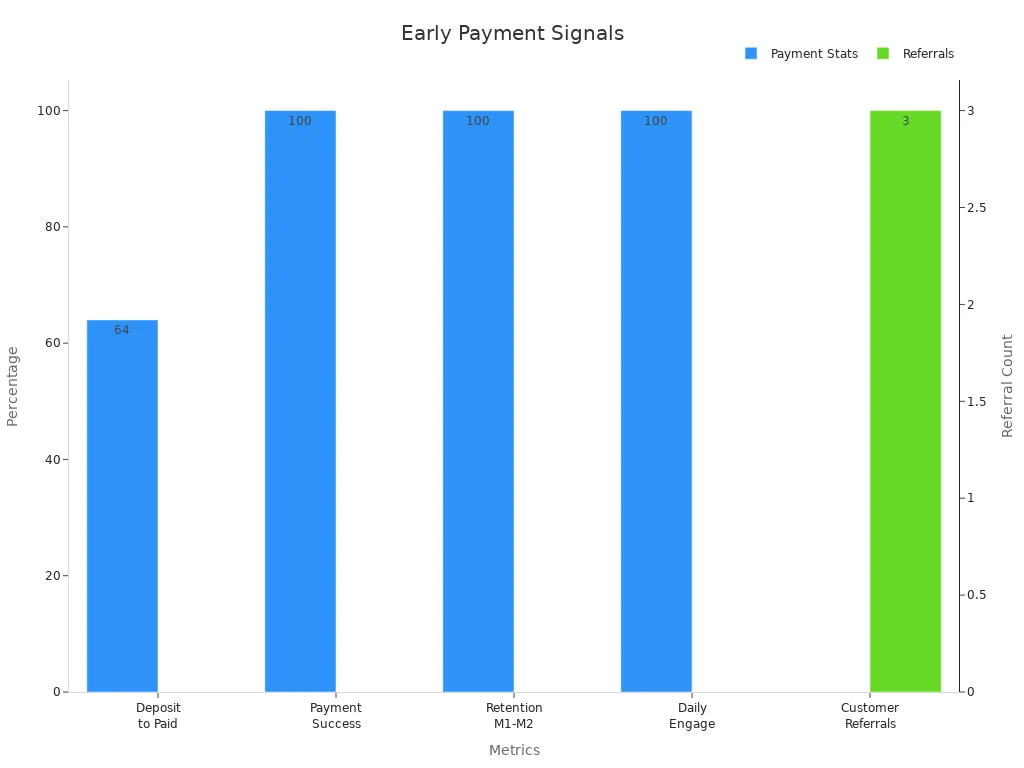How to validate your SaaS AI idea effectively in 2025

You have a big idea for SaaS AI, but how do you know if real people want it? In 2025, you need to validate your saas idea by testing demand before you build anything. Forget the old idea-build-pray method. Start with the market. Use AI tools to spot pain points and talk to users. Build an MVP fast with no-code. Watch for early payment signals. Let real feedback shape your idea and make smart moves with AI-driven data.
Key Takeaways
Begin by looking for real problems your SaaS AI can fix. Talk to users and use AI tools to find what bothers them.
Learn about your target audience by studying their needs and habits. See what solutions they use now. This helps you make your product fit them better.
Make a clear and special value proposition that shows why your SaaS AI is different. Test this idea with your audience.
Build a simple no-code MVP fast. Try it out with real users. Use what they say to make it better quickly.
Watch important numbers like user engagement and early payments. Use these to choose if you should keep going, change your plan, or stop.
SaaS AI Validation Steps
Identify Pain Points
Begin by looking for big problems people face. Try to find tasks that make people upset or waste their time. Ask yourself, “What main problem can my SaaS AI fix?” This is more important than following what is popular. When you find the problem, you are ready to make a good product.
You can use AI tools to check forums, review sites, and social media. Search for complaints, questions, or people asking for better answers. Visit small online groups like IndieMaker or certain subreddits. These places show what your audience deals with every day.
Tip: Do not just guess. Talk to real users. Ask about their daily work and what slows them down. A simple chat can help you find great ideas.
Here is a process many founders use:
Think of many ideas without judging them.
Look at old launches on Product Hunt and Flippa to see what worked.
Talk to your audience in online groups and get feedback.
Make a simple landing page to see if people want to sign up.
Choose if you want to build, buy, or bootstrap based on what you have.
Jasper AI started by fixing a real problem for marketers. They helped people make content faster, checked the idea with early users, and grew from there. This shows that checking your idea step by step helps you build a strong SaaS AI product.
Define Target Audience
You must know who you want to help. Knowing your target market lets you focus and saves time. Start with user research. Collect facts like age, job, company size, and where they live. Add info about how users fix their problems now. What tools do they use? This helps you shape your SaaS idea.
Use AI-powered tools to study user research data. Look for patterns in how your audience acts. Split your audience by job, company size, or industry. This makes your message and product better for each group.
Demographic data: age, gender, location, job, income, company size, industry, job roles.
Feedback: support tickets, online reviews, social media comments.
User research like interviews and surveys helps you check your idea. You can see what your customer really needs. When your product matches your market, you have a better chance of success.
Note: Tools like Hotjar and SEMrush help you collect and study user research data. Use what you learn to make a solution that fits your customer’s real needs.
Craft Unique Value Proposition
Now, you need to be different. Your unique value proposition (UVP) tells your customer why your SaaS AI is special. A clear UVP helps users understand your idea quickly. It also helps more people sign up and trust you.
Let’s look at some numbers:
Lead/Trial Type | Conversion Rate | What It Means for UVP |
|---|---|---|
Marketing Qualified Leads (MQLs) | Low conversion if UVP is unclear | |
Product Qualified Leads (PQLs) | 25-30% | High conversion when users get the UVP |
Free trials (credit card upfront) | 50% | Clear UVP makes users want to try |
Free trials (no credit card) | 25% | Less commitment, UVP may need work |
When you share your UVP with videos or clear words, you can get up to 86% more signups. Trello’s website is a good example. Their UVP is easy to understand, so users trust and try the product.
Pro Tip: Test your UVP with your target market. Use landing pages, videos, or short demos. See if users understand it right away. If not, change your message until it works.
A strong UVP, built on real user research and checking your idea, helps your SaaS AI idea stand out. Focus on fixing real problems for your customer, and you will get closer to success.
Engage Users for Validation
User Interviews and Feedback
You can learn a lot by talking to real people. Start with interviews, one person at a time. These talks help you know what users want. You find out what makes them upset. You also learn why they might pick your SaaS AI. Interviews give you stories that surveys miss. You hear what is really going on.
Ask open questions about what people do each day and what bothers them.
Use AI tools to look at feedback and find patterns or feelings.
Do interviews and also send out short surveys to get more feedback.
AI-powered analytics like Userpilot show where users get stuck. They can guess which users might leave soon. This helps you fix your product before problems grow. Using both interviews and AI tools helps you check your idea. It also makes customers happier.
Evidence Type | Examples and Metrics |
|---|---|
NPS, CSAT, product usage numbers, survey rates, Slack finds 72% of UX issues | |
Qualitative Data | Deep interviews, customer stories, long talks every few months, advice from special groups |
Online Community Discussions
You need to talk to your audience where they spend time online. Join subreddits, Discord, or LinkedIn groups. Ask questions, share your idea, and listen to what people say. Real proof comes when users do more than just say they like it.
Get feedback with polls, forms, and open talks.
Watch things like how long people use it, if they leave, and if they sign up to see if your idea works.
When you check your idea in these places, you get honest answers. You also see if your idea really helps people.
Early Payment Signals
Getting paid early is the best proof for your idea. If someone pays, even a little, your idea solves a real problem. Track bills, deposits, and if people keep paying to see if they stay. Early payments show real interest and help you know if your SaaS AI is ready for more steps.

Metric Description | Example Statistic |
|---|---|
Deposit to Paid Subscription Conversion | |
Payment Success on Signed Contracts | 100% of signed contracts got paid |
Retention from Month 1 to Month 2 | 100% of users stayed |
Daily Engagement with Core Features (Month 2) | 100% of users used main features every day |
Customer Referrals in First Month | 3 users told another business about it |
Early payments and strong feedback are the best ways to check your SaaS AI idea before you build more.
Market and Competitor Research

Analyze Market Demand
You want to make sure your SaaS AI idea has real demand. Start by looking at how the market is growing. AI is now a standard feature in many SaaS products. The AI market could reach $1,812 billion by 2030. That’s huge! More SaaS companies are adding AI features every year. Almost 75% of popular SaaS apps can train AI models using customer data. This shows strong demand for new solutions.
When you do user research, focus on what people need right now. AI-driven hyper-personalization boosts conversion rates by 30%. AI chatbots solve up to 80% of customer questions, cutting costs and making users happier. Predictive analytics help companies make smarter decisions. These trends show that the market wants tools that save time, cut costs, and improve results.
Tip: Use user research to find out if your target market faces these same problems. If they do, your idea is on the right track.
Validate App Ideas with AI Tools
You can validate app ideas much faster with AI tools. These tools scan huge amounts of data and spot patterns that people might miss. They also help you automate user research and validation steps. Check out this table to see how AI tools compare to old-school methods:
Metric | AI Tools | Traditional Methods |
|---|---|---|
Efficiency & Speed | Automate tasks, process data fast, keep learning | Slow, manual, needs lots of effort |
Cost | Higher at first, but saves money over time | Cheaper at first, but costs more as you grow |
Accuracy | Finds hidden patterns, less bias | More errors, depends on people |
Collaboration | Frees up your team for big-picture work | Team stuck doing manual work |
AI tools let you focus on strategy while they handle the heavy lifting. You get better validation and can move faster.
Spot Gaps and Trends
Spotting gaps in the market helps you stand out. AI-powered user research tools like Insight7 and SEMrush Market Explorer scan reviews, forums, and social media. They find what users want but can’t get. Real-time competitive intelligence lets you track what your rivals do—like price changes or new features—without hours of manual research.
AI tools also dig deep into user research, picking up on hidden frustrations and unmet needs. They give you live feedback on your app ideas, messaging, and pricing. Still, you need to use your own judgment to make sense of the data. The best results come when you mix AI insights with your own business smarts.
Note: The market keeps changing. Keep doing user research and validation to stay ahead.
Build a No-Code MVP

Use Momen for Prototyping
You do not need to know how to code to build your first mvp. Tools like Momen make it easy to create a working version of your SaaS AI idea. With Momen, you can set up a strong backend that handles lots of data and users. You get features like real-time monitoring, load balancing, and easy scaling. Momen lets you test your idea fast and see if it works in the real world.
Here’s what makes Momen and other no-code mvp tools stand out:
Efficiency Aspect | Supporting Evidence & Examples |
|---|---|
Time Reduction | MVP development time drops from months to weeks. TaskFlow built their mvp in just 4 weeks. |
Cost Savings | No need for big tech teams, saving thousands of dollars. |
Rapid Iteration | AI collects feedback and helps you improve your product quickly. |
Accessibility | Non-technical founders can prototype and test ideas fast. |
Market Validation | AI tools give you insights and automate data collection, lowering risk. |
User Engagement | FinTrack saw a 30% jump in user engagement after testing features with an AI-powered mvp. |
No-code mvp platforms like Momen help you move from idea to testable product without waiting months or spending a fortune.
Test with Real Users
Once you have your mvp, share it with real users. Watch how they use it. Ask them what they like and what confuses them. Use simple metrics to track how well your SaaS AI works. For example, check how many users finish tasks, how long it takes, and how often they come back.
Metric | What It Means | Why It Matters |
|---|---|---|
Success Score | How many users complete tasks | Shows if your mvp helps users reach their goals |
Error Rate | How often users make mistakes | Points out where your mvp needs fixing |
Retention | How many users keep coming back | Tells you if your mvp is valuable |
CSAT | How happy users are with your product | High scores mean users like your mvp |
Testing with real users gives you honest feedback. You see what works and what needs to change.
Iterate Fast
Move quickly. Use what you learn from users to make your mvp better. Launch updates often. This helps you find product-market fit before spending too much time or money. Research shows that startups using no-code tools can cut costs by up to 85%. If you launch your mvp early, you get real data and can make smart choices.
Tip: Most startups fail because they build something nobody wants. Rapid iteration with a no-code mvp helps you avoid this mistake.
Keep improving your mvp until users love it. If they do not, change your idea or try a new approach. Fast feedback and quick changes are your best tools for success.
Measure and Decide
Track Key Metrics
You need to track the right numbers to know if your SaaS AI idea is working. Start with urgency, willingness to pay, and engagement. These show if people really want your product and if they will stick around. You can also measure interest by looking at how many users sign up, return, or share your tool with others.
Here’s a table with key metrics and real-world examples:
Metric Category | How to Measure | Example Result |
|---|---|---|
Cost Reduction | Compare expenses before and after AI | Saved $500,000 a year by cutting downtime |
Productivity & Time Saved | Track how fast tasks get done | Data entry time dropped by 80% |
Revenue Impact | Use A/B tests or compare sales before and after | AI upsell added $2 million in sales |
Customer Experience | Check CSAT, NPS, and churn rates | AI chatbot raised NPS and cut wait times |
Error Reduction | Count mistakes before and after AI |
These numbers give you actionable insights to validate your saas idea. When you see strong results, you know you are on the right path.
Interpret Validation Data
Now, look at your data and feedback to see what it means. Start by checking user interviews, surveys, and how people use your MVP. You want to measure interest by tracking daily and monthly active users. High engagement and happy users mean your idea solves a real problem.
Follow these steps to make sense of your data:
Gather feedback from interviews, surveys, and usability tests.
Compare your product to others to spot gaps.
Use landing pages to see if people sign up before launch.
Watch out for common mistakes like ignoring negative feedback or skipping user research.
Spend at least 2-4 weeks testing and learning before building more.
AI tools can help you spot patterns and find what users love or dislike. They also help you avoid bias and save time.
Pivot, Persevere, or Stop
After you measure interest and study your feedback, you need to decide what to do next. If your key metrics keep growing and users love your product, keep going. If you see lots of negative feedback or low engagement, it might be time to pivot—change your idea or focus. Sometimes, stopping is the smartest move if nothing works.
Here’s a quick checklist to help you decide:
Are users coming back and telling friends?
Do people pay or ask for more features?
Is your team excited and able to deliver?
Are you seeing better results than before?
AI agents can help by tracking metrics, collecting feedback, and even suggesting changes. They save you time and give you a clear view of what works. Remember, the best founders listen to users and let data guide their next steps.
You can bring your SaaS AI idea to life by following a clear path. Start with market goals and research. Build user personas and test your ideas with real people. Create a simple MVP and gather feedback. Use no-code tools and AI to move fast. Watch for early payments and keep improving. This step-by-step process helps you build products people want and find success in the market.
Set market validation goals and questions.
Study the market and trends.
Build user personas from research.
Test ideas with prototypes and interviews.
Launch an MVP for early adopters.
Collect feedback and improve your product.
Take action now. Listen to users, test quickly, and let real data guide your next move.
FAQ
How do I know if my SaaS AI idea solves a real problem?
Talk to real users. Ask about their daily struggles. If people say, “I need this now,” or offer to pay, you have a real problem to solve. Early payment is the best signal.
What tools can help me validate my SaaS AI idea quickly?
You can use no-code platforms like Momen for MVPs. Try AI tools such as SEMrush, Hotjar, or Insight7 for research. These tools help you gather feedback, spot trends, and test ideas fast.
How much should I spend on validation before building?
Keep costs low. Use free or low-cost tools. Spend just enough to test your idea with real users. Most founders spend less than $500 before building a full product.
What if users don’t like my MVP?
Don’t worry! Use their feedback to improve your product. Change features, update your message, or try a new idea. Fast changes help you find what works.
Can I validate my SaaS AI idea without knowing how to code?
Yes! No-code tools let you build and test ideas without coding. You can create landing pages, simple apps, or prototypes. Focus on solving problems, not writing code.
See Also
Top Strategies To Integrate AI Into SaaS Products 2025
Best SaaS Startup Concepts To Start In 2025
Learn Proven Methods To Profit From AI In 2025

